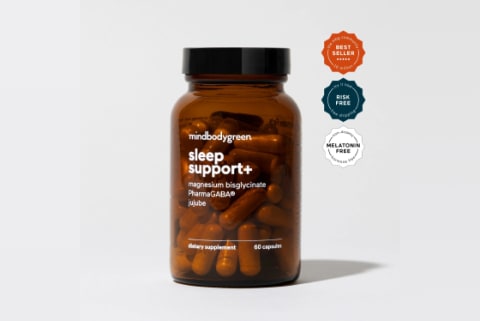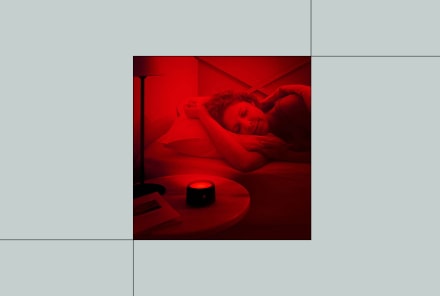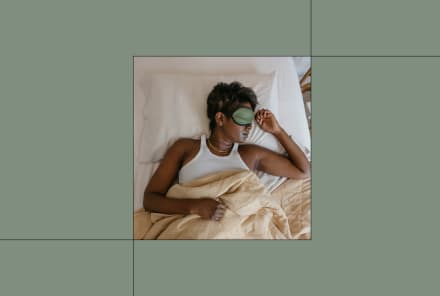Advertisement
After Years Of Being A Night Owl, This Is How I Started Going To Bed Earlier


My name's Emma, and I'm a recovering bedtime procrastinator.
My nights used to consist of snacking, scrolling through my phone, watching TV—anything I could do to put off bedtime just a little bit longer. This was my way of reclaiming my schedule after exceptionally busy days.
Carving out time to chill and unwind after work is undoubtedly important—but I took this overboard for a while. Spending so much of my evenings on screens (which are known to inhibit melatonin production and mess with your natural sleep-wake rhythms) only encouraged me to stay up later and later. I went through years thinking I was a night owl before realizing that wasn't the case: Technology was just tricking me into thinking I wasn't that tired when, in reality, my body was craving an earlier bedtime.
This isn't all that surprising, considering that light plays a huge role in regulating our circadian rhythms1. And as I recently learned from holistic psychiatrist Ellen Vora, M.D., some of us are more sensitive to it than others. Vora previously shared with mindbodygreen that she, too, used to consider herself more of a night owl before realizing that she was just particularly sensitive to light after sunset.
"If I see light in the evening, it suppresses my melatonin, and I can feel wide-awake for hours. If I get the proper light cues in the evening (i.e., darkness after sunset rather than the psychedelic light show of modern life), I can get sleepy at an appropriate time," Vora writes. Who else can relate?
It took me a while to identify my energizing triggers and get closer to my true sleep schedule. I'm still far from perfect, but these are the changes that I've found most helpful for breaking up with my former night owl persona:
How I stopped being such a night owl
I replaced TV time with offscreen activities
Step one of getting into my natural sleep rhythm was laying off the screen time. While I'll still enjoy the occasional episode of TV before bed, I do so infrequently; it's more of a special treat. In its place, I've tried to switch to off-screen wind-down activities like reading, talking with my partner, or doing chores around my apartment. I do occasionally have to wrap up some work on my computer before bed; when that happens, I wear these blue-light-blocking glasses to minimize the disruption to my melatonin levels.
I stopped drinking so much coffee after noon
Adjusting my coffee intake has also made a huge difference in my sleep schedule. I used to think that I was one of those rare people who didn't lose sleep after drinking caffeine late in the day. Well, while that 4 p.m. coffee might not have made it any harder for me to fall asleep, I realized that it was reducing my overall sleep quality once I started using a sleep tracker.
I now keep most of my caffeine drinking before noon thanks to a counterintuitive hack: I wait 90 minutes after waking up to have my first cup, allowing my body to wake itself up naturally and reducing the need for an afternoon pick-me-up. This has majorly benefited my sleep quality and helped me feel more tired at the end of the day.
I started taking sleep support+
Probably the most significant change I've made is introducing sleep support+ to my routine.
This sleep supplement combines three relaxing ingredients: magnesium bisglycinate, jujube, and PharmaGABA®. Taking it about 30 minutes before I plan to go to bed has helped me fall asleep faster and stay asleep longer. (Read all about the results I saw after week one of taking it here.)*
This supplement has had the positive ripple effect of helping me wake up earlier in the morning feeling more refreshed. This also means that by the time 11 p.m. rolls around, I'm consistently tired and ready for bed. I've also found that I feel more excited to get under the covers—and less tempted by unwatched episodes of Bravo—now that I know how restorative a night of great sleep can really feel.*
While I'm still far from a morning person (working on it), these changes have helped me establish a more regular sleep routine that feels in sync with my body.
The takeaway
There's nothing wrong with being a night owl; some people naturally thrive on schedules that start and end later in the day and that's perfectly OK. We're all unique, but after years of a wonky bedtime routine, I realized that I personally would feel a lot better if I started going to bed a smidgen earlier. Limiting my coffee intake, replacing TV time with other activities, and taking sleep support+ have helped me do just that. Watching the stroke of midnight is now a distant memory—and one that I really don't miss at all.
Watch Next
Enjoy some of our favorite clips from classes
Enjoy some of our favorite clips from classes
What Is Meditation?
Mindfulness/Spirituality | Light Watkins
Box Breathing
Mindfulness/Spirituality | Gwen Dittmar
What Breathwork Can Address
Mindfulness/Spirituality | Gwen Dittmar
The 8 Limbs of Yoga - What is Asana?
Yoga | Caley Alyssa
Two Standing Postures to Open Up Tight Hips
Yoga | Caley Alyssa
How Plants Can Optimize Athletic Performance
Nutrition | Rich Roll
What to Eat Before a Workout
Nutrition | Rich Roll
How Ayurveda Helps Us Navigate Modern Life
Nutrition | Sahara Rose
Messages About Love & Relationships
Love & Relationships | Esther Perel
Love Languages
Love & Relationships | Esther Perel
What Is Meditation?
Box Breathing
What Breathwork Can Address
The 8 Limbs of Yoga - What is Asana?
Two Standing Postures to Open Up Tight Hips
How Plants Can Optimize Athletic Performance
What to Eat Before a Workout
How Ayurveda Helps Us Navigate Modern Life
Messages About Love & Relationships
Love Languages
Advertisement

This Little-Known Supplement Helps Women Sleep & Decreases Signs Of Depression
Molly Knudsen, M.S., RDN

Want To Be Metabolically Healthy? New Study Shows An Underutilized Approach
Molly Knudsen, M.S., RDN

This Little-Known Supplement Helps Women Sleep & Decreases Signs Of Depression
Molly Knudsen, M.S., RDN

Want To Be Metabolically Healthy? New Study Shows An Underutilized Approach
Molly Knudsen, M.S., RDN














